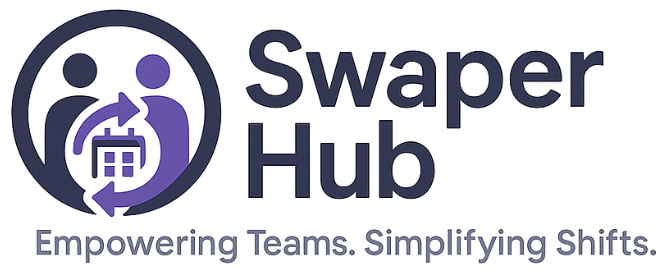Why Preventing Coverage Gaps Matters for Hourly Teams
How to Prevent Coverage Gaps with Smart Shift Swap Strategies
Coverage gaps aren’t just an inconvenience — they disrupt workflows, frustrate teams, and put customers at risk. The good news? You can prevent most of them with smart, proactive shift swap strategies. In this guide, we’ll show you how.
1. Make Shift Availability Transparent
One of the most common reasons teams experience last-minute coverage issues is a lack of real-time visibility into shift availability. Without a centralized system to view openings or available teammates, shifts often go unclaimed until it’s too late. With tools like SwaperHub, employees can easily view and respond to scheduling needs as they arise.
Providing visibility also empowers employees to plan ahead. When workers can see open shifts or peers willing to trade, it creates a proactive culture of accountability. This not only improves coverage but boosts morale and teamwork across the board.
2. Encourage Preemptive Swaps
Instead of waiting until the last minute to scramble for replacements, give your team the ability to initiate swap requests in advance. A digital request system, like the one integrated in SwaperHub, lets employees trade shifts directly—no paperwork or hallway conversations required.
This autonomy builds trust and reduces the administrative burden on managers. It also allows workers to maintain better work-life balance by taking control of their own availability. Over time, the team becomes more self-reliant, efficient, and less prone to absentee-driven chaos.
3. Automate Manager Notifications
Even with self-service tools, managers still need oversight. Automation is the key. SwaperHub instantly notifies supervisors the moment a shift is dropped, picked up, or swapped. These real-time alerts eliminate guesswork and ensure that decisions are backed by the most up-to-date information.
Automation also removes delays that occur when messages are relayed manually, missed in email inboxes, or lost in group chats. With built-in automation, leadership stays informed—without micromanaging.
4. Track Swap Fairness & Load Balance
It’s critical to track how swaps are distributed across your team. Without oversight, some staff may become overworked by always filling in, while others may frequently drop shifts. SwaperHub includes fairness metrics to help managers monitor usage patterns and workload distribution.
These insights support decisions that keep things equitable—reducing burnout and creating a more inclusive, supportive environment. Over time, balanced shift coverage improves performance, retention, and satisfaction.
5. Offer Incentives for Picking Up Unclaimed Shifts
Recognition goes a long way. When employees go above and beyond to help cover shifts, make sure they know it matters. Whether it’s a shoutout during a team meeting, a small bonus, or even just leaderboard visibility in SwaperHub, simple incentives foster a culture of mutual support.
These recognition-based systems help fill gaps faster and build team cohesion. In environments where customer service or patient care is critical, timely shift coverage can make or break the day.
6. Standardize Shift Swap Policies
Many organizations struggle with shift chaos simply because the rules aren’t clear. Who can approve swaps? How far in advance are they required? What happens if someone doesn’t show up? By formalizing these policies and embedding them into your scheduling tool, ambiguity disappears.
When policies are consistently enforced, everyone plays by the same rules. That stability gives managers peace of mind and gives staff the confidence to plan ahead.
7. Integrate Shift Tools with Team Communication Platforms
The best swap systems don’t operate in isolation. They work hand-in-hand with the platforms your team already uses—like Slack, Teams, or internal messaging systems. By integrating shift notifications and approval flows into these channels, you reduce friction and ensure important updates are seen and acted on immediately.
This unified approach to communication and scheduling ensures your team is never out of sync. From reducing missed messages to speeding up response times, integration is the final piece that ties your entire shift strategy together.
✅ Ready to Close the Gaps?
Shift coverage gaps don’t have to be a recurring problem. With SwaperHub, your team gains visibility, flexibility, and confidence—all through a centralized platform built for shift-based operations. Whether you’re in healthcare, retail, or hospitality, smart swap strategies give your team a competitive edge.
Sign up today and explore how SwaperHub can transform your team’s coverage process, improve morale, and protect business continuity. It’s time to make every shift count.
Try SwaperHub Free →Want to go deeper? Check out our Top 5 Shift Swap Challenges guide.


Leave a Reply